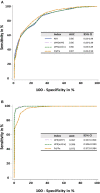Comparison of Resting Full-Cycle Ratio and Fractional Flow Reserve in a German Real-World Cohort
- PMID: 35004875
- PMCID: PMC8740550
- DOI: 10.3389/fcvm.2021.744181
Comparison of Resting Full-Cycle Ratio and Fractional Flow Reserve in a German Real-World Cohort
Abstract
Objective: The aim of this study was to evaluate non-hyperemic resting pressure ratios (NHPRs), especially the novel "resting full-cycle ratio" (RFR; lowest pressure distal to the stenosis/aortic pressure during the entire cardiac cycle), compared to the gold standard fractional flow reserve (FFR) in a "real-world" setting. Methods: The study included patients undergoing coronary pressure wire studies at one German University Hospital. No patients were excluded based on any baseline or procedural characteristics, except for insufficient quality of traces. The diagnostic performance of four NHPRs vs. FFR ≤ 0.80 was tested. Morphological characteristics of stenoses were analyzed by quantitative coronary angiography. Results: 617 patients with 712 coronary lesions were included. RFR showed a significant correlation with FFR (r = 0.766, p < 0.01). Diagnostic accuracy, sensitivity, specificity, positive predictive value, and negative predictive value of RFR were 78% (95% confidence interval = 75; 81), 72% (65; 78), 81% (77; 84), 63% (57; 69), and 86% (83; 89). Relevant predictors for discordance of RFR ≤ 0.89/FFR > 0.8 were LAD lesions, peripheral artery disease, age, female sex and non-focal stenoses. Predictors for discordance of RFR > 0.89/FFR ≤ 0.8 included non-LCX lesions, percent diameter stenosis and previous percutaneous coronary intervention in the target vessel. RFR and all other NHPRs were highly correlated with each other. Conclusion: All NHPRs have a similar correlation with the gold standard FFR and may facilitate the acceptance and implementation of physiological assessments of lesion severity. However, we found ~20% discordant results between NHPRs and FFR in our "all-comers" German cohort.
Keywords: coronary artery disease (CAD); coronary physiology; fractional flow reserve (FFR); invasive coronary angiography (ICA); resting full-cycle ratio (RFR).
Copyright © 2021 Wienemann, Meyer, Mauri, Baar, Adam, Baldus and Halbach.
Conflict of interest statement
SB and MH received institutional grant support and speakers' honoraria from Abbott Vascular. HW received institutional grant support from Abbott Vascular. Abbott Vascular had no influence on the design of the study, data analysis or interpretation of findings. The remaining authors declare that the research was conducted in the absence of any commercial or financial relationships that could be construed as a potential conflict of interest.
Figures




Similar articles
-
Predictors of discordance between fractional flow reserve and resting full-cycle ratio in patients with coronary artery disease: Evidence from clinical practice.J Cardiol. 2021 Mar;77(3):313-319. doi: 10.1016/j.jjcc.2020.10.014. Epub 2020 Nov 21. J Cardiol. 2021. PMID: 33234404
-
Prevalence of myocardial perfusion scintigraphy derived ischemia in coronary lesions with discordant fractional flow reserve and non-hyperemic pressure ratios.Int J Cardiol. 2022 Jun 15;357:20-25. doi: 10.1016/j.ijcard.2022.02.031. Epub 2022 Feb 24. Int J Cardiol. 2022. PMID: 35219745
-
Diagnostic performance of quantitative flow ratio versus fractional flow reserve and resting full-cycle ratio in intermediate coronary lesions.Int J Cardiol. 2022 Sep 1;362:59-67. doi: 10.1016/j.ijcard.2022.05.066. Epub 2022 May 31. Int J Cardiol. 2022. PMID: 35662563
-
Pooled diagnostic accuracy of resting distal to aortic coronary pressure referenced to fractional flow reserve: The importance of resting coronary physiology.J Interv Cardiol. 2018 Oct;31(5):588-598. doi: 10.1111/joic.12517. Epub 2018 Apr 29. J Interv Cardiol. 2018. PMID: 29707808 Review.
-
Instantaneous wave-free ratio as an alternative to fractional flow reserve in assessment of moderate coronary stenoses: A meta-analysis of diagnostic accuracy studies.Cardiovasc Revasc Med. 2018 Jul-Aug;19(5 Pt B):613-620. doi: 10.1016/j.carrev.2017.12.014. Epub 2017 Dec 27. Cardiovasc Revasc Med. 2018. PMID: 29371084 Review.
Cited by
-
Comparison of Fractional Flow Reserve and Resting Full-Cycle Ratio in the Functional Assessment of Coronary Artery Stenosis in Patients with Non-ST-Segment Elevation Acute Coronary Syndrome.Rev Cardiovasc Med. 2024 Jul 11;25(7):260. doi: 10.31083/j.rcm2507260. eCollection 2024 Jul. Rev Cardiovasc Med. 2024. PMID: 39139424 Free PMC article.
-
Invasive physiologic assessment of coronary artery stenosis by resting full-cycle ratio and fractional flow reserve: a prospective observational study.Sci Rep. 2023 Sep 22;13(1):15783. doi: 10.1038/s41598-023-43082-1. Sci Rep. 2023. PMID: 37737284 Free PMC article.
-
[Discordance between fractional flow reserve and nonhyperemic index with a fiber-optic pressure wire. READI EPIC-14].REC Interv Cardiol. 2024 Mar 6;6(3):158-165. doi: 10.24875/RECIC.M24000448. eCollection 2024 Jul-Sep. REC Interv Cardiol. 2024. PMID: 40415774 Free PMC article. Spanish.
-
Contemporary Functional Coronary Angiography: An Update.Future Cardiol. 2024;20(14):755-778. doi: 10.1080/14796678.2024.2416817. Epub 2024 Oct 24. Future Cardiol. 2024. PMID: 39445463 Review.
-
Prognostic impact of resting full-cycle ratio and diastolic non-hyperemic pressure ratios in patients with deferred revascularization.Clin Res Cardiol. 2023 Sep;112(9):1220-1230. doi: 10.1007/s00392-022-02149-1. Epub 2023 Jan 5. Clin Res Cardiol. 2023. PMID: 36602599 Free PMC article.
References
-
- Zimmermann FM, Ferrara A, Johnson NP, van Nunen LX, Escaned J, Albertsson P, et al. . Deferral vs. performance of percutaneous coronary intervention of functionally non-significant coronary stenosis: 15-year follow-up of the DEFER trial. Eur Heart J. (2015) 36:3182–8. 10.1093/eurheartj/ehv452 - DOI - PubMed
-
- van Nunen LX, Zimmermann FM, Tonino PA, Barbato E, Baumbach A, Engstrøm T, et al. . Fractional flow reserve versus angiography for guidance of PCI in patients with multivessel coronary artery disease (FAME): 5-year follow-up of a randomised controlled trial. Lancet. (2015) 386:1853–60. 10.1016/S0140-6736(15)00057-4 - DOI - PubMed
LinkOut - more resources
Full Text Sources
Miscellaneous

